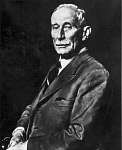Hubert Cecil Booth
| Hubert Cecil Booth | |
|---|---|
 | |
| Born |
4 July 1871 Paris, France |
| Died |
14 January 1955 (aged 83) Croydon, England |
| Nationality | British |
| Education | City and Guilds Institute, London |
|
Engineering career | |
| Discipline | Civil engineer |
| Institutions | Institution of Civil Engineers |
| Significant advance | Invented vacuum cleaner |
Hubert Cecil Booth (4 July 1871 – 14 January 1955)[1] was a British engineer who invented the first powered vacuum cleaner.[2][3][4]
He also designed Ferris wheels,[1][5] suspension bridges and factories.[1] Later he became Chairman and Managing Director of the British Vacuum Cleaner and Engineering Co.[1]
Early life
Booth was born in Paris, France, although his family moved to Gloucester when he was 2 months old. He was educated at Gloucester College and Gloucester County School under headmaster Reverend H. Lloyed Brereton. In 1889 he entered the Central Technical College, City and Guild, London[6] after passing the entrance examination. He completed a three-year course in civil engineering and mechanical engineering under Professor William Cawthorne Unwin FRS. He completed the Diploma of Associateship (ACGI), coming second in the engineering department. He became a student of the Institution of Civil Engineers.[1]
Career
In December 1892 he entered the drawing office of Messrs Maudslay Sons & Field, Lambeth, London under Mr Charles Sells, as a civil engineer. In this capacity he designed bridges and large ferris wheels for amusement parks in London, Blackpool, Paris, and Vienna.[1]
He worked on the design of engines for Royal Navy battleships.[6] After seeing a rather inadequate demonstration of a compressed air based cleaning system for railway carriages at St Pancras station, Booth reasoned that sucking air through a filter might be a better system, and thus invented an early version of the vacuum cleaner which was manufactured by Fielding & Platt of Gloucester. His approach was better suited for industrial use than for household use, and his company was soon overtaken by his competitor, Hoover. He received British patents for his work on February 18 and August 30, 1901, and his company continued to specialize in industrial vacuum cleaners.[3] Before Booth introduced his version of the vacuum cleaner, cleaning machines blew or brushed dirt away, instead of sucking it up. All modern vacuums are based on Booth's principle.
Personal life
Booth married one of the daughters of Francis Tring Pearce, director of the Priday, Metford and Company Limited. He was a friend of Hugh Pembroke Vowles. Booth died on 14 January 1955 in Croydon, England.[1]
References
- 1 2 3 4 5 6 7 Institution of Civil Engineers. "OBITUARY. HUBERT CECIL BOOTH. 1871-1955" (PDF). ICE Proceedings, Volume 4, Issue 4, pages 631 –632. Thomas Telford Publishing.
- ↑ "Sucking up to the vacuum cleaner". www.bbc.co.uk. 2001-08-30. Retrieved 2008-08-11.
- 1 2 Wohleber, Curt (Spring 2006). "The Vacuum Cleaner". Invention & Technology Magazine. American Heritage Publishing. Retrieved 2010-12-08.
- ↑ Cole, David; Browning, Eve; E. H. Schroeder, Fred (2003). Encyclopedia of modern everyday inventions. Greenwood Press. ISBN 978-0-313-31345-5.
- ↑ "Far-right fury over British bid for Vienna wheel". The Telegraph. Telegraph Media Group Limited. 4 Jun 2008. Retrieved 2010-12-20.
- 1 2 "Hubert Cecil Booth". Gloucestershire County Council. Retrieved 2010-12-21.